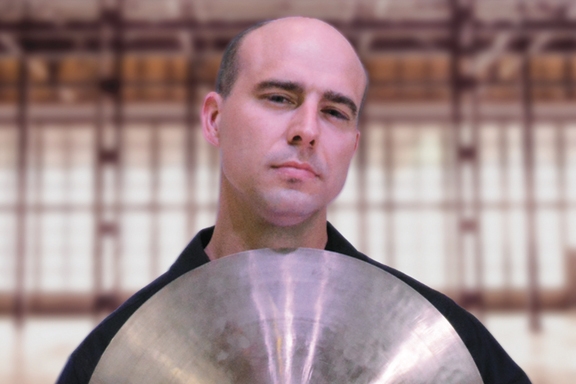A showcase of solos, marimba and tuba concertos put the spotlight on a host of West Michigan Symphony musicians during this season’s second masterworks concert.
Scheherazade Showcase features a unique program that gives two musical instruments — marimba and tuba — and their players a chance to shine on the Frauenthal Theater stage. The symphony’s principal percussionist Matt Beck and principal tuba Clinton McCanless will move to the front as they show off their instruments.
Very few concertos have been composed for marimba and tuba, and Conductor Scott Speck considers them masterpieces of the symphony repertoire.
“I am thrilled to show our audience up close the mastery and artistry that they can regularly hear from the back of the stage,” he said.
Meanwhile, Kevin Puts’ Marimba Concerto was written in 1997 when the composer was 25 years old.
Puts grew up in Alma, studied at Yale University and the Eastman School of Music, and teaches composition. He has written concertos for instruments that are featured less often in front of the orchestra: oboe, clarinet, percussion and marimba.
“The marimba itself is more of a solo instrument and less of an orchestral instrument,” Beck said. “It’s hard to believe he was that young to produce such a mature work. It really demonstrates his understanding of the expressive qualities of the instrument.”
Puts’ Marimba Concerto reflects his love of Mozart’s piano concertos and features the marimba in both melodic and ornamental roles as it continually interacts with the instruments of the orchestra. Comprised of three movements — fast, slow, fast — the piece’s overriding message is “one of optimism and exuberance,” according to the program notes.
Comprised of a set of wooden bars struck with mallets, like a xylophone, the marimba’s bars are arranged like keys on the piano. Marimbists stand behind the instrument and manipulate four mallets at a time. Resonators, pipes suspended underneath the bars, help create a lower sound that reverberates after the initial strike.
The instrument produces a sound that is quite mellow and very warm. Yet, people can expect an instrument every bit as expressive as a violin or piano, Beck said.
The marimba is one of many instruments Beck uses as principal percussionist, but it’s his first time playing this particular concerto. He lives in Grand Rapids, owns a business selling and repairing instruments and also performs as principal percussionist with Lansing Symphony, Battle Creek Symphony and Canton Symphony. This is his 14th year with West Michigan Symphony.
It’s nearly unheard of to have a tuba soloist featured on a symphony program, and Vaughan Williams’ Tuba Concerto marked a milestone for the youngest instrument of the orchestra. The first major concerto written for tuba, Williams’ concerto “was initially viewed as an eccentric piece from an aging composer” but became one of his most popular works, according to the program notes.
The British composer wrote his Tuba Concerto in 1954 to celebrate the 50th anniversary of the London Symphony Orchestra. The tuba was introduced in the 1830s but didn’t become a standard symphony instrument until the second half of the 19th century.
The concerto displays the instrument’s wide range, from its lowest notes to its lyrical vocal quality featured in the Romanza second movement. “Fast passages, wide leaps and quick trills” characterize the showy cadenzas that conclude the first and last movements.
Tuba Concerto shows off some of the technical capabilities of the tuba as an instrument, and takes a few years for tuba students to master, said McCanless, also an assistant professor of tuba and euphonium at the University of Louisville.
McCanless first joined the WMS in 2010 while doing doctoral work at Michigan State University. He drives from Louisville to perform with the symphony and is a former first-place winner at the International Tuba Euphonium Association solo competition and the Leonard Falcone International Euphonium and Tuba competition.
“It’s a very good regional orchestra,” he said. “I’m definitely looking forward to it. I enjoy solo playing.”
Rounding out the program, Nikolai Rimsky-Korsakov’s Scheherazade is a “sparkling, beloved” tone poem with solo parts for violin, clarinet, oboe and horn, to name a few.
The piece by Russian composer Rimsky-Korsakov tells a story through music that is pictorial and descriptive and became his most popular orchestral work. Based on the Middle Eastern folk tale, One Thousand and One Nights, the piece features different instruments and melodic themes assigned to specific characters in the story, according to the program notes.
The basses and other low instruments represent the evil Sultan’s aggressive, domineering nature. Concertmaster Jennifer Walvoord depicts the role of Scheherazade with tender and soft violin solos throughout the work. As the story continues, various instruments and groups take the lead in the different “tales” of One Thousand and One Nights, giving many symphony musicians the chance to shine in solo and symbiotic roles.
Scheherazade Showcase
West Michigan Symphony
Frauenthal Center, 425 W. Western Ave., Muskegon
Nov. 2, 7:30 p.m., $24-$60
westmichigansymphony.org





